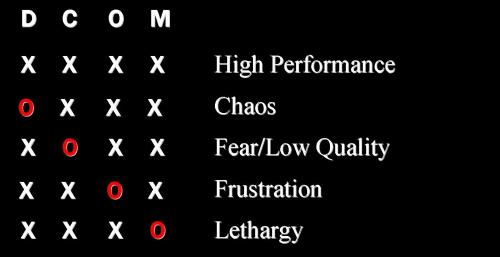
We must be data driven!We must manage by fact!What happens when we don’t have any data? What happens when we can’t tweak a bit of machinery to improve our primary metric? What happens when one of our critical Xs is a behavioural problem?Or, one of our action items in the Improve stage is something a person has to do, who for the last 10 years has been working that process in a different way, their way?
This is when behavioural science can help RDMAICT and some techniques are summarised as follows:
Recognise Stage: For greatest behaviour change pick the projects where people are feeling the pain NOW and a defect causes almost immediate problems not problems that MAY be felt in two years time.
Lesson 1 in behavioural science (At Bechtel they call it Performance Based Leadership) was peoples’ behaviour changes the quickest when consequences are immediate and certain. When consequences are in the future and are uncertain the motivation to change is negligible.
Measure Stage: When going through tools like the fishbone, be conscious that where there are behavioural Xs they may be a lack of one or more of the following;
- Direction: Have people been told clearly what to do, and the strategic reason behind why they have to do the task a certain way.
- Competence: Simply do they have the skills to do what they have been told.
- Opportunity: Have they the time and tools (amongst other things) to do the job
- Motivation: Have the factors that motivate that individual and his team to do the job right first time been considered. This analysis is subjective. The table below shows what happens when you have full DCOM and when you have a stage missing.

Figure 1: DCOM Model (Bechtel)
Improve Stage: Actions not being completed in your implementation Plan? Chances are that particular task has not got a consequence attached to it.
Again, these consequences must be immediate and certain. They can be positive (preferable) or negative. An effective consequence is booking team members in to ‘present out’ their part of the project to the executive on a specific date. If that doesn’t get the action done the person is either near retirement, a masochist who loves being shown up and reprimanded in public or plain mad.
Lesson 2 in behavioral science was telling people to do something is often not enough; a consequence has to be in place to ensure the task is done.
Control Stage: Your team members have all spent time and effort in your workshops. When the project is complete and you’re sipping tea with the boss, the cash saving projected on the wall behind you, don’t forget them, don’t take all the credit. This will lead to “extinction”; basically they have made the effort and want some recognition but have had little or no reward. When the call comes for project 2 I lay a penny to a pound that they won’t be volunteering. Team members need plenty of Positive Reinforcement. They are our customers at the end of the day.
These are just some of the techniques you can use. The main thing is to use these tools not ad hoc, but everyday, until they become “business as usual”.
What behavioral techniques do you use within the RDMAICT process?